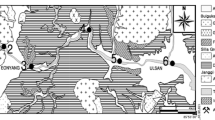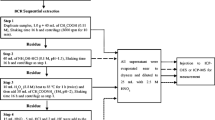Abstract
To assess the risk of release and percentage of heavy metals in river sediment, nine stations were set up to sample surface sediments from three important rivers situated southwest of the Caspian Sea (the Shafaroud, Karaganroud, and Choubar Rivers). Chemical analyses were conducted on sediment with particle sizes of >38, 63–38, 63–125, 125–250, 250–500 and 500–1000 µm using metal fractionation to determine the degree of risk release and the heavy metal pollution. Common risk indices were used including the cumulative indices of pollution intensity assessment and risk release standards (the modified pollution degree and ecological risk). Generally, when sediment sizes are decreased, the concentration of heavy metals is both larger and greater than the mean concentration of global sediments and earth crust. However, in this research, the concentration of all the metals did not necessarily increase with a decrease in the size of particles. In fact, concentration of cobalt, vanadium, cadmium, and chromium was greater in sediment particle sizes over 63 μm. The results of chemical fractionation analyses indicated that the release risk of metals has two initial phases for: (1) exchangeable bond (F1) and (2) carbonated bond (F2). When compared with other metals, nickel had the greatest tendency to bond within the loose exchangeable phase (F1) across all the stations. Furthermore, with changes in the size of particles, the percentage of heavy metal changes across different bond phases, but will be the greatest in the loose exchangeable phase (F1). This was observed with cobalt, nickel, and chromium at particle sizes larger than 63 μm. The results of ecological risk and modified pollution degree indices indicated that the highest level of pollution was related to sediments with sizes between 63 and 250 μm. Eventually, in order to assess the risk extent of metals present in sediment, a cumulative index referred to as the modified risk assessment code was utilized. It suggested that the greatest risk of toxicity in some stations has been related to particles larger than 63 μm.










Similar content being viewed by others
References
Allen RJ (1979) Sediment-related fluvial transmission of contaminants: some advances in 1979. Scientific Series No. 107. Environment Canada, Ottawa
Alloway BJ (1990) Heavy metals in soils. Blackie and Son, Glasgow
Alvim MCM, Lourenco JCN (2000) The influence of organic matter content of contaminated soils on the leaching rate of heavy metals. Environ Prog 19(1):53–58
Asadian F, Arzjani Z, Varavipour M (2010) Changes of microenvironment in Gilan city due to landsides. Carpath J Earth Environ Sci 5:93–102
ASTM D4698-92 (2013) Standard practice for total digestion of sediment samples for chemical analysis of various metals
Bettinetti R, Giarei CA, Provini A (2003) Chemical analysis and sediment toxicity bioassays to assess the contamination of the River Lambro (Northern Italy). Arch Environ Contam Toxicol 45:72–78
CaeiroS Costa MH, Ramos TB, Fernandes F, Silveira N, Coimbra A, Medeiros G, Painho M (2005) Assessing heavy metal contamination in Sado Estuary sediment: an index analysis approach. Ecol Ind 5:151–169
Calmano W, Hong J, Förstner U (1993) Binding and mobilization of heavy metals in contaminated sediments affected by pH and redox potential. Water Sci Technol 28(8–9):223–235
Casas JM, RosasH Solé M, Lao C (2003) Heavy metals and metalloids in sediments from the Llobregat basin, Spain. Environ Geol 44:325–332
Chabukdhara M, Nema A (2012) Assessment of heavy metal contamination in Hindon River sediments: a chemometric and geochemical approach. Chemosphere 87(8):945–953
Chen M, Ma LQ, Harris WG (1999) Baseline concentrations of 15 trace elements in Florida surface soils. J Environ Qual 28:1173–1181
Darvish Bastami K, Neyestani MR, ShemiraniF Soltani F, Haghparast S, Akbari A (2015) Heavy metal pollution assessment in relation to sediment properties in the coastal sediments of the southern Caspian Sea. Mar Pollut Bull 92:237–243
Devesa-Rey R, Díaz-Fierros F, Barral MT (2010) Trace metals in river bed sediments: an assessment of their partitioning and bioavailability by using multivariate exploratory analysis. J Environ Manage 91(12):2471–2477
Dickinson WW, Dunbar GB, McLeod H (1996) Heavy metal history from cores in Wellington Harbour, New Zealand. Environ Geol 27:59–69
Dong D, Nelson YM, Lion LW, Shuler ML, Ghiorse WC (2000) Adsorption of Pb and Cd onto metal oxides and organic material in natural surface coatings as determined by selective extractions: new evidence for the importance of Mn and Fe oxides. Water Res 34:427–436
Eghbal MK, Givi J, Torabi H, Miransari M (2012) Formation of soils with fragipan and plinthite in old beach deposits in the South of the Caspian Sea, Gilan province Iran. Appl Clay Sci 64:44–52
Elder JF(1989) Metal biogeochemistry in surface-water systems-a review of principles and concepts: U.S. Geological Survey Circular
Forstner U, Ahlf W, Calmano W (1989) Studies on the transfer of heavy metals between sedimentary phases with a multi-chamber device: combined effects of salinity and redox potential. Mar Chem 28:145–158
Geological Survey of Iran (GSI) (2014) Comperehnsive reports of Guilan Province
Greaney KM (2005) Master’s Thesis. School of Life Sciences, Heriot-Watt University, Edinburgh an Assessment of Heavy Metal Contamination in the Marine Sediments of Las Perlas Archipelago, Gulf of Panama
Gunn AM, Winnard DA, Hunt DTE (1988) Trace metal speciation in sediments and soils. In: Kramer JR, Allen HE (eds) Metal speciation: theory analysis and application., Lewis Publications, Boca Raton, pp 261–294
Guven D, Akinci G (2013) Effect of sediment size on bioleaching of heavy metals from sediment of Izmir Inner Bay. J Environ Sci 25(9):1784–1794
Hakanson L (1980) Ecological risk index for aquatic pollution control, a sedimentological approach. Water Res 14:975–1001
Harrison RM, Laxen DPH, Wilson SJ (1981) Chemical associations of lead, cadmium, copper, and zinc in street dusts and roadside soils. Environ Sci Technol 15(11):1378–1383
Hart B (1982) Uptake of trace metals by sediments and suspended particulates: a review. Hydrobiologia 91:299–313
Hursthouse A, Matthews J, Figures J, Iqbal-Zahid P, Davies I, Vaughan D (2001) chromium behaviour in intertidal sediments and pore waters, R. Clyde UK. Environ Geochem Health 23:253–259
Jain CK (2004) Metal fractionation study on bed sediments of River Yamuna, India. Water Res 38:569–578
Jaradat QM, Massadeh AM, Zaitoun MA, Maitah B (2006) Fractionation and sequencial extraction of heavy metals in the soil of scrap yard of discarded vehicles. Environ Monit Assess 112:197–210
John DA, Leventhal JS (1995) U.S. Department of the Interior, U.S. Geological Survey, Preliminary compilation of descriptive geoenvironmental mineral deposit models. In: du Bray EA (ed) Bioavailability of metals, Open-File Report 95–0831, pp 10–18
Kabata-PendiasA A, Mukherjee A (2007) Trace elements from soil to human. Springer, Berlin
Karbassi AR, Fakhraee M, Heidari M, Vaezi AR, Valikhani Samani AR (2014) Dissolved and particulate trace metal geochemistry during mixing of Karganrud River with Caspian Sea water. Arab J Geosci 8(4):2143–2151
Lak R, Saeedi M, Vosoogh A (2015) Heavy metals distribution in fractioned river sediments, case study: shafaroud River-south west of Caspian Sea. Int J Environ Sci Dev 6(7):530–534
Leontiev OK, Owen L, Kowarev AN (2016) Caspian Sea. online Encyclopedia Britannica article. Last updated 1-2016
Li XD, Lee SL, Wong SC, Shi WZ, Thorntonc I (2004) The study of metal contamination in urban soils of Hong Kong using a GIS-based approach. Environ Pollut 129:113–124
Lopez-Sanchez JF, Rubio R, Samitier C, Rauret G (1996) Trace metal partitioning in marine sediments and sludges deposited off the coast of Barcelona (Spain). Water Res 30:153–159
Luoma SN (1983) Bioavailability of trace metals to aquatic organisms-A review. Sci Total Environ 28:1–22
Miller J (1997) The role of fluvial geomorphic processes in the dispersal of heavy metals from mine sites. J Geochem Explor 58:101–118
Morillo J, Usero J, Rojas R (2008) Fractionation of metals and As in sediments from a biosphere reserve (Odiel salt marshes) affected by acidic mine drainage. Environ Monit Assess 139(1–3):329–337
Ogunfowokan AO, Oyekunle JAO, Durosinmi LM, Akinjokun AI, Gabriel OD (2009) Speciation study of lead and manganese in roadside dusts from major roads in Ile-Ife South Western Nigeria. Chem Ecol 25(6):405–415
Ogunfowokan AO, OyekunleJ AO, Olutona GO, Atoyebi AO, Lawal A (2013) Speciation study of heavy metals in water and sediments from Asunle River of the Obafemi Awolowo University, Ile-Ife Nigeria. Int J Environ Protect 3:616
Olajire AA, Ayodele ET, Oyediran GO, Oluyemi EA (2003) Level of speciation of heavy metals in soils of industrial Southern Nigeria. Environ Monit Assess 85:135–155
Pacifico R, Adamo P, Cremisini C, Spaziani F, Ferrara L (2007) A geochemical analytical approach for the evaluation of heavy metal distribution in lagoon sediments. J Soils Sediments 7(5):313–325
Pagnanelli F, Moscardini E, Giuliano V, Toro L (2004) Sequentional extraction of heavy metals in river sediments of an abandoned pyrite mining area: pollution detection and affinity series. Environ Pollut 132:189–201
Paramasivam K, Ramasamy V, Suresh G (2015) Impact of sediment characteristics on the heavy metal concentration and their ecological risk level of surface sediments of Vaigai River, Tamilnadu, India. Spectrochim Acta Part A Mol Biomol Spectrosc 137:397–407
Pardo R, Barrado E, Lourdes P, Vega M (1990) Determination and speciation of heavy metals in sediments of the Pisuerga River. Water Res 24(3):373–379
Pehlivan R (2010) The effect of weathering in the Buyukmelen River basin on the geochemistry of suspended and bed sediments and the hyrogeo chemical characteristics of river water, Duzce, Turkey. J Asian Earth Sci 39:62–75
Pendias AK, Pendias H (1992) Trace Elements in Soils and plants, 2nd edn. Florida CRC Press, Boca Raton
Ramos L, Gonzalez MJ, Hernandez LM (1999) Sequential extraction of copper, lead, cadmium and zinc in sediments from Ebro River (spain): relationship with levels detected in earthworms. Bull Environ Contam Toxicol 62(3):301–308
Rath P, Panda UC, Bhatta D, Sahu KC (2009) Use of sequential leaching, mineralogy, morphology and multivariate statistical technique for quantifying metal pollution in highly polluted aquatic sediments-A case study: Brahmani and Nandira Rivers, India. J Hazard Mater 163:632–644
Saeedi M, Jamshidi-Zanjani A (2015) Development of a new aggregative index to assess potential effect of metals pollution in aquatic sediments. Ecol Indic 185:235–243
Salomons W (1995) Environmental impact of metals derived from mining activities: processes, predictions, prevention. J Geochem Explor 52:5–23
Salomons W, Förstner U (1980) Trace metal analysis of polluted sediments. Part 2. Evaluation of environmental impact. Environ Technol Lett 1:506–517
Sharma VK, Rhudy KB, Koeing R, Baggett S, Vazquez FG (1999) Metals in sediments of Texas estuaries, USA. J Environ Sci Health 34:2061–2073
Singh KP, Malik A, Basant N, Singh VK, Basant A (2007) Multi-way data modeling of heavy metal fractionation in sediments from Gomti River (India). Chemometr Intell Lab Syst 87(2):185–193
Tessier A, Campbell PGC, Bisson M (1979) Sequential extraction procedure for the speciation of particulate trace metals. Anal Chem 51:844–851
USEPA (1996) 3050B Acid digestion of sediments, sludges and soils
Varol M, Sen B (2012) assessment of nutrient and heavy metal contamination in surface water and sediments of the upper Tigris River, Turkey. CATENA 92:1–10
Yang Z, Wang Y, Shen Z, Niu J, Tang Z (2009) Distribution and speciation of heavy metals in sediments from the mainstream, tributaries, and lakes of the Yangtze River catchment of Wuhan, China. J Hazard Mater 2–3:1186–1194
Yi Y, Yang Z, Zhang S (2011) Ecological risk assessment of heavy metals in sediment and human health risk assessment of heavy metals in fishes in the middle and lower reaches of the Yangtze River basin. Environ Pollut 159:2575–2585
Zimnitskava H, von Geldern J (2011) Is the Caspian Sea a sea; and why does it matter? J Eurasian Stud 2(1):1–14
Acknowledgments
All costs for implementation of this research including the costs of sampling operations and relevant experiments were paid by the Geological Survey of Iran (GSI). The authors of this study express their appreciation for this assistance and for the honorable presidency and personnel in this organization.
Author information
Authors and Affiliations
Corresponding author
Rights and permissions
About this article
Cite this article
Vosoogh, A., Saeedi, M. & Lak, R. Metal fractionation and pollution risk assessment of different sediment sizes in three major southwestern rivers of Caspian Sea. Environ Earth Sci 76, 292 (2017). https://doi.org/10.1007/s12665-017-6603-z
Received:
Accepted:
Published:
DOI: https://doi.org/10.1007/s12665-017-6603-z




